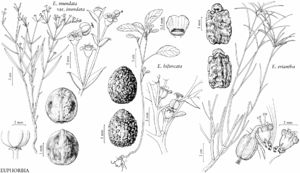Difference between revisions of "Euphorbia eriantha"
Bot. Voy. Sulphur, 51. 1844.
FNA>Volume Importer |
imported>Volume Importer |
||
| (2 intermediate revisions by 2 users not shown) | |||
| Line 50: | Line 50: | ||
|publication year=1844 | |publication year=1844 | ||
|special status=Illustrated | |special status=Illustrated | ||
| − | |source xml=https:// | + | |source xml=https://bitbucket.org/aafc-mbb/fna-data-curation/src/2e0870ddd59836b60bcf96646a41e87ea5a5943a/coarse_grained_fna_xml/V12/V12_73.xml |
|genus=Euphorbia | |genus=Euphorbia | ||
|section=Euphorbia sect. Poinsettia | |section=Euphorbia sect. Poinsettia | ||
Latest revision as of 19:17, 5 November 2020
Herbs, annual or perennial, with slender to thick, woody taproot. Stems erect to ascending, 10–75 cm, glabrous or with scattered appressed hairs (especially near nodes); branches arcuate. Leaves alternate; petiole 0.1–0.4 mm, often indistinct, glabrous or sparsely pilose to shortly sericeous; blade linear to linear-elliptic, 20–55 × 1–3 mm, base attenuate, margins entire or with 2–4 inconspicuous teeth near apex, apex acute, abaxial surface pilose to shortly sericeous, adaxial surface usually glabrous, rarely pilose to shortly sericeous; only midvein conspicuous. Cyathial arrangement: terminal cymose branches 1, 1–2-branched; pleiochasial bracts 2–3, opposite or whorled, wholly green, similar in shape and size to distal leaves; dichasial bracts similar in shape to distal leaves or often highly reduced. Cyathia: peduncle 1–1.9 mm. Involucre obconic, 2.1–2.6 × 1.3–2 mm, canescent; involucral lobes triangular, obscured by hairs; glands (2–)4–5, green to maroon, color often obscured by hairs, sessile and broadly attached, 0.5–0.6 × 0.5–0.6 mm, opening oblong to nearly circular, densely canescent; appendages petaloid, whitish, hoodlike, incurved and covering glands, 0.5–1 × 0.5–0.8 mm, divided into 5–12 fringed, subulate segments, densely canescent. Staminate flowers 20–25. Pistillate flowers: ovary canescent; styles 0.9–1.5 mm, unbranched. Capsules oblong to ovoid, 4.4–4.9 × 3.5–4.1 mm, canescent (often with interspersed glabrescent patches); columella 3.5–3.9 mm. Seeds mottled black and gray or light brown, oblong or slightly ovoid, dorsiventrally compressed in cross section, 2.8–4.1 × 2–2.4 mm, irregularly pitted and tuberculate; caruncle 0.4–0.8 × 0.6–1.1 mm.
Phenology: Flowering and fruiting year-round in response to sufficient rainfall.
Habitat: Desert scrub on rocky slopes and along washes.
Elevation: 60–800 m.
Distribution

Ariz., Calif., N.Mex., Tex., Mexico (Baja California, Baja California Sur, Chihuahua, Coahuila, Durango, San Luis Potosí, Sonora).
Discussion
Selected References
None.
